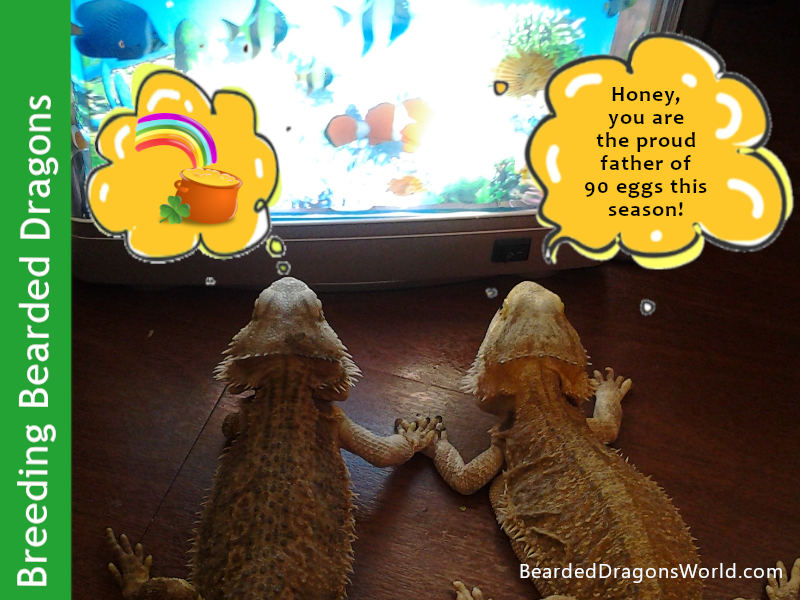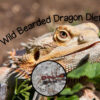Bearded dragon breeding can be fun and educational. Bearded dragon’s are one of the most prolific breeders of all lizards and need little help to produce dozens and dozens of young each year.
Bearded dragons are oviparous (produce young by eggs) and can deliver multiple clutches a year. Females have 2 germinal beds in each ovary and all four can be active at the same time. This means a new clutch can be started before the first one has been laid (Amey and Whittier, 2000).
Jump To…
Attracting a Mate – Pheromones
Bearded dragons utilize a system of chemical communication through the secretion of pheromones, particularly during the breeding season. These pheromones are produced by specialized glands known as femoral pores, which are located on the inner thighs of these reptiles. The waxy substance secreted by the femoral pores is rich in pheromones and plays a pivotal role in sexual signaling and territorial behaviors (Baeckens et al., 2017).
During the breeding season, male bearded dragons exhibit an increase in femoral pore activity, producing more of this waxy secretion. This is believed to convey information about the male’s reproductive status and territorial claims, serving as a chemical attractant to females and a deterrent to rival males (Baeckens et al., 2015). Females, in turn, may use these chemical cues to assess the fitness and suitability of potential mates, thus influencing mating decisions and breeding success (Baeckens et al., 2017).
This chemical communication via femoral pore secretions underscores the complex social and reproductive behaviors of bearded dragons, highlighting the importance of pheromonal signals in their natural history and breeding ecology.
Bearded Dragon Breeding Stages
The reproductive stages the female goes through are:
- Brumation*
- Copulation
- Gravid
- Egg laying
- Non reproductive
While some exotic animals require brumation to reproduce, bearded dragons are not one of them. These prolific breeders can be reproduced with or without brumation.
The reproductive stages of the male goes through are:
- Brumation
- Spermatogenesis
- Spermatic activity briefly interrupted
Sexual Maturity – When a Bearded Dragon Breeding Age
What age do female bearded dragons breed and start laying eggs?
Bearded dragon breeding starts when they reach a physical size, not so much chronological age.
In the wild, bearded dragons will typically be expected to come of breeding age between 1 and 2 years of age.
Bearded dragon breeding age can change in captivity. As pet bearded dragons are often provided food in excess of their needs, growth can also speed up. Given this, a bearded dragon could well become sexually mature before a year of age if it reached the appropriate size (Melidone, 2008).
Once the female is sexually mature she is vitellogenic, can become gravid (with or without mating) and can lay eggs.
Female bearded dragons are vitellogenic and gravid (fertile and pregnant) from spring to early summer (Amey and Whittier, 2000), this is when mating and egg laying occurs.
Wild female Pogona minor were noted by Pianka (date unknown) to reach sexual maturity at approximately 90 mm length snout to vent and that the females slightly outweigh the males.
Stauber and Booth (2003) recorded sexual maturity in female Pogona barbata has been reached when the snout to vent length was between 110.5 mm and 119.5 mm. The male body is bigger than the females.
| Pogona species – Females | Sexual Maturity |
| Pogona minor (small bearded dragon’s) | 90 mm |
| Pogona barbata (large bearded dragon’s) | 110.5-119.5 mm |
Bearded Dragons can Lay Eggs without a Mate!
A female bearded dragon does not need a mate to start laying eggs, it will occur as a part of the normal reproductive cycle. However, if there hasn’t been a mate within the breeding season, the eggs will not be fertile.
Female bearded dragons can store sperm in oviductal crypts within a breeding season (Amey and Whittier, 2000). This means a bearded dragon can lay clutches of fertile eggs without a second mating in the same season. To guarantee the parentage of a bearded dragon you should only mate to one male per season or you will not know which is the father of a particular hatchling.
What Age Can Male Bearded Dragons Breed and When are they Fertile
A male bearded dragon (Pogona barbata) is sexually mature and can start breeding when it reaches a snout to vent length of between 127.5 mm and 135.5 mm (Stauber and Booth, 2003). Maximum snout to vent length for Pogona barbata is 25 cm (Badham as cited Stauber and Booth, 2003).
A wild male Pogona minor (bearded dragon) is sexually mature at approximately 80 mm snout to vent length (Pianka, date unknown).
| Pogona species – Males | Sexual Maturity |
| Pogona minor (small bearded dragon’s) | 80 mm |
| Pogona barbata (large bearded dragon’s) | 127.5-135.5 mm |
Male bearded dragons are fertile all year around except for a short time in late summer (Amey and Whittier, 2000).
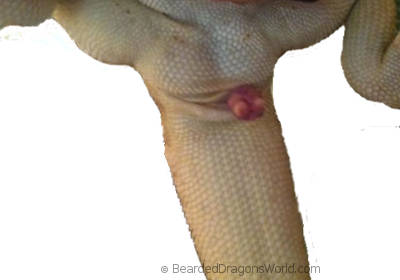
Bearded Dragons Mating
Bearded dragon mating can appear quite violent. Bearded dragons breed very easily.
The male will approach and circle the female. His beard will be darkened, and he will bob his head up and down. The female will respond by bobbing her head up and down and waving her arm in a circular motion.
The male will secure the female by holding on to her neck or shoulder skin with his mouth. The male everts his hemipenis and once their cloaca are aligned, he inserts either one or both of his hemipene into the female’s cloaca. Once the female is ready to be let go, she will raise her head to a vertical position.
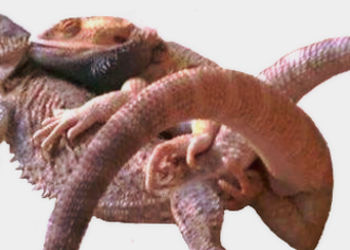
Sperm can be stored by the female within the breeding season. This means that breeding by another male during the breeding season means the parentage of the offspring will be unknown. It could have been the first male, or it could be the second.
Interestingly, research by Lane (2013) found that male bearded dragon’s check out their rivals (other males with their bearded darkened, a threat) with their right eye, at least on first pass.
How to look after a Pregnant (Gravid) Bearded Dragon
Bearded Dragon is Pregnant, what do I do?
To care for your pregnant bearded dragon (usually referred to as gravid):
- Review calcium supplementation and D3 and ensure heating and lighting are working well
- Prepare a dig box
- Decide whether you will be hatching all the eggs, hatching a select few or none at all
Now that your bearded dragon is pregnant, calcium reserves may be depleted quickly. The yolks take a large amount of calcium and it is also required for the shells. The yolk is responsible for creating the embryo which includes the bones.
Calcium supplementation, lighting and heating are even more important than before for the development of the embryos and the health of the pregnant bearded dragon. She will also need the reserves for oviposition and muscle contractions to lay the eggs. If this isn’t right, MBD (linked post by Donald Buchanan, DVM) is a threat.
Ensure you are providing as much natural sunlight as possible while she is gravid, so that she can make all the D3 she needs. This is a much more reliable way of getting vitamin D3 than supplementation. Calcium supplementation will need to be increased. More on that in the post Creating Healthy Bearded Dragons – Guide to Calcium and Vitamin D3.
Once you become aware your bearded dragon is pregnant, provide a lay box. She need environmental cues to lay eggs, without this she can become egg bound which can be disastrous.
When will my bearded dragon lay eggs? The time between mating and laying eggs for bearded dragons is around 4 to 6 weeks.
Within a week or two before she is ready to lay the eggs, the bearded dragon’s digging will becoming increasingly more intense. If she isn’t digging, she probably doesn’t have what she needs to dig in and will likely be moving up and down the enclosure as if trying to escape…that’s because she is trying to escape to lay her eggs somewhere she sees as suitable.
Providing a suitable container, in the right location with a suitable substrate to lay eggs, is critical. If she refuses to use the lay box, then it isn’t suitable for her.
The lay box can be sand or vermiculite. Vermiculite is a common substrate used in both research environments and breeding. The material should be free of fecal matter and other waste or pathogens that can result in fungus.
Provide a large lay box container with vermiculite slightly dampened to at least a depth of 30 cm (10-12 or so inches). Dampening (not wet) the vermiculite will help it stay in place a little better as she digs and the eggs shouldn’t stick to the vermiculite.
Thompson and Thompson (2003) recorded the wild Western Bearded Dragon (Pogona minor) creating test holes around 10 cm deep and then laid their eggs in burrows 20 cm deep. Pianka (date unknown) recorded similar with female bearded dragons laying eggs in open sandy areas at around 15-20 cm deep.
Put the container in a place that is accessible to your bearded dragon. Some will be fine in open spaces, but others may prefer some privacy and security cover. Placing the container lid half over the container should be sufficient privacy. Leave her to lay and bury the eggs. Once she has finished you can remove the container.
If you find she is not settling with the lay box, try moving it and/or adding other material such as moistened moss.
“Maternal diet influences yolk fatty acid content and yolk size, thus affecting offspring nutrition.”
Stephen Divers and Scott Stahl, 2018
Should all the eggs be hatched?
Bearded dragons are so easy to breed and so prolific that they are unfortunately bred to excess.
For every bearded dragon that hatches you will need to feed it. Some will need to be housed separately as each will grow at different rates creating hazards for the smaller ones. Hatchlings will often bite off toes, tails and more of their siblings.
Rather than adding to the already large population, consider hatching just a few of the eggs.
Bearded Dragon Eggs from Brother – Inbreeding
If the fertile eggs are a result of two siblings, the eggs must be destroyed. All of the eggs may not hatch and for those that do, inbreeding can result in severe birth defects.
How to get Rid of Bearded Dragon Eggs
Can I freeze bearded dragon eggs? As the nervous system has not yet developed in freshly laid eggs, you can cull the number of eggs by freezing any excess.
For eggs that are less than 50% through gestation they can be destroyed by freezing for 4 hours at less than 4°C (39°F) (Animal Care & Use Standard, 2019). After this stage they will need to be euthanized humanely (Animal Care & Use Standard, 2019).
This is not a suitable method for euthanizing, do not do this with a formed reptile.
How long it takes for a bearded dragon to lay Eggs
The female bearded dragon will lay eggs 2-3 weeks after being mated. She should lay her eggs within the day.
Once the eggs are laid, she may protect them on and off for a few hours. That is the sum total of her maternal care done.
How Many Eggs Do Bearded Dragons Lay?
Large bearded dragons can lay 90 odd eggs in a season.
The number of eggs per clutch ranges. The Pogona vitticeps in the wild is known to lay 7-35 eggs with the least being for those that live in the more arid areas such as the Big Desert (Robertson 2014) and will produce around 2-3 clutches in a year.
The Pogona minor produces less. Three clutches of eggs (from 3 different females) were observed for the wild free roaming Pogona minor with each having 8 to 10 eggs (Thompson and Thompson, 2003). Others have been found to have 3 to 12 eggs (Pianka, date unknown).
The wild Pogona barbata has been recorded laying up to 3 clutches of up to 35 eggs (Amey and Whittier, 2000)
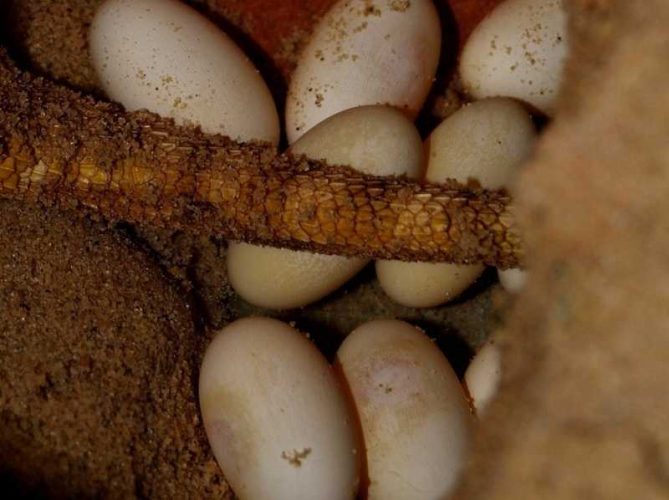
How do I know when my bearded dragon is ready to lay her eggs (Oviposition)?
You know your bearded dragon is pregnant and getting ready to lay her eggs when she:
- Spends more time basking.
- Starts to put on weight rapidly. Perhaps 30% more within a few weeks.
- Becomes increasingly swollen, lumpy and bumpy across the abdomen over the next 2-3 weeks before she lays her eggs.
- Has smaller bowel movements or perhaps not move her bowels as much.
- Probably slows down on, or stops eating. This may be within days to a week of laying.
- Starts moving around as if she is looking for something. She is, she is looking for a place she considers suitable for laying eggs. She will do lots of test digging.
If she cannot get to a suitable place to lay eggs, she will likely pace and look like she wants to escape. Actually, she probably does want to escape, she needs the right place to lay her eggs. Being unable to lay them will become life threatening within a very short time, days.
Wanting to see the event is understandable, but she might not see it that way. If she is hissing at you during laying, back off a little. She just needs a little privacy. Once she has laid the eggs, she will fill in the hole packing it down with her nose every so often until the hole is filled.
Oviposition can take hours. She may not lay all her eggs at once. If the oviposition goes into days, she will start to become exhausted. It could indicate being egg bound which will require veterinary intervention. If the eggs are not laid and she appears exhausted or any other signs of struggle, see the article on egg bound bearded dragon (dystocia).
Once she has finished, she has probably lost around 20-30% of her body weight. She will look quite skinny, this is normal. Provide her with water, food and additional calcium to start the recovery. Again, sunshine without anything in between her and the sun is ideal along with foods rich in calcium.
Three female bearded dragons (Pogona minor) observed by Thompson and Thompson (2003) in the wild lost between 31.2 to 36.5% of their body weight after oviposition. The two biggest started at 72.5 grams and weighed in at 46 and 47.4 grams after laying their eggs. The female Pogona minor observed by Painka (date unknown) lost around 19.5% of their body weight after oviposition.
How to care for bearded dragons eggs
To care for bearded dragons eggs:
- Using a small container big enough to fit the eggs in (about an inch apart), add a mix of 4 parts vermiculite to 5 parts of water. The mix should be damp, not wet (dripping). It is better to add more water later than too much at any one time. Eggs need moisture from the air, not the substrate. The containers should have lids with ventilation holes.
- Transfer the eggs to a small container half filled with vermiculite, half burying them. Place each egg from the lay box into the small container in the same orientation you find them. The eggs should not touch the lid or sides of the container.
- Monitor the eggs until they hatch. If condensation forms on the lids, there is too much moisture. Remove the lid for a day to reduce the moisture content. If the eggs start collapsing then spray some more water on the substrate, not the eggs.
The maternal care bearded dragons provide is limited to protecting the eggs on the initial laying of them. The eggs should not remain with the bearded dragon in captivity, any young that hatch will likely end up as a meal.
Eggs need the right amount of heat, air and water to successfully hatch.
How long does it take for the eggs to hatch?
The temperature the eggs are kept at determines how long they will take to hatch. Incubation takes between 50 – 70 days at 29°C (84°F) or longer if the temperature is cooler. The eggs will hatch over a couple of days. From the moment of hatching, the bearded dragons are ready to face their world, no parental care is given.
Incubation for the Pogona vitticeps in the wild takes between 10-12 weeks and the young will hatch with a snout to vent length of 36-42 mm (Robertson 2014).
In the wild, 3 separate clutches of the free ranging Pogona minor were recorded taking 59 to 74 days to hatch at an incubation temperature of 27°C (80.6°F) (Thompson and Thompson, 2003).
Within a day or two prior to hatching, the eggs will start to deflate and small droplets of water may start to appear on the surface of the egg. The eggs may not show the signs of hatching at the same time as they will likely hatch at different times over a period of days.
Baby bearded dragons can have a fleshy pinkish mass on their belly exactly where you might expect a belly button to be. This is the egg sack, not an injury and will be reabsorbed within a few days.
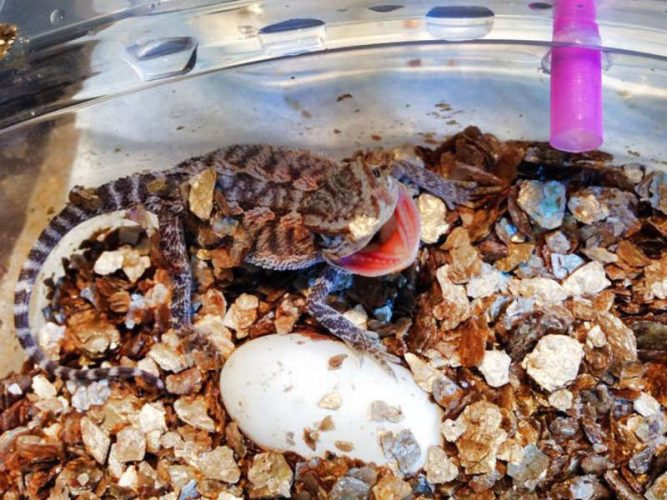
The temperature you incubate at, impacts behaviour
Incubate bearded dragon eggs that you intend to keep. The incubation temperature impacts the behavior of the bearded dragons. In an experiment by Siviter (2015) eggs were split into two groups and incubated at temperatures 27 (±3°C) [80.6°F] (cold group) and 30 (±3°C) [86°F] (hot group). The cold group hatched in around 60 days whereas the cold group hatched by 91 days.
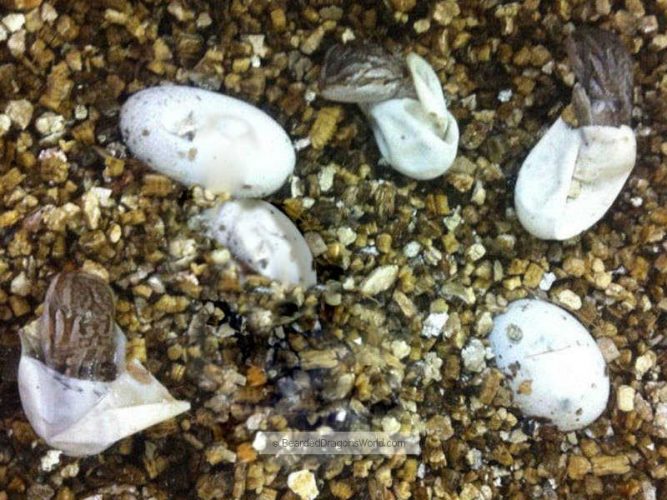
Those incubated at the lower temperature grew faster than those in the hot group. The difference in growth rate and weight really started to show at 10 weeks of age and by the time they were 18 weeks old the colder group weighed in the mid 60 gram mark while the hot group were in the 30 gram mark.
Rapid growth may not be beneficial for long term health.
The group was tested for foraging behaviour, feeding on crickets. The hot group were not as good at foraging as the colder group.
It was also found that there was some short term differences in early developmental stages but they would grow out of the differences leaving no noticeable long term effect.
How to care for Hatchlings (baby bearded dragons)
Some hatchlings will grow faster than the others. The different sizes will need to be separated from each other to protect the smaller ones and give them a little less competition of resources to grow just as well. It is not abnormal for hatchlings kept together to bite off toes and what not of their mates.
The hatching size will vary for the species. The 3 clutches of free ranging wild Pogona minor (previously mentioned in this post) hatched at a mean snout to vent length of 36.1 mm and just 1.74 grams.
Feed baby bearded dragons small invertebrate such as cockroaches and crickets. The hatchlings can be quite active chasing prey.
How long does it take for a baby bearded dragon to grow to full size? Baby bearded dragons will grow to full size within 2 years. In captivity they will usually grow quicker due to conditions.
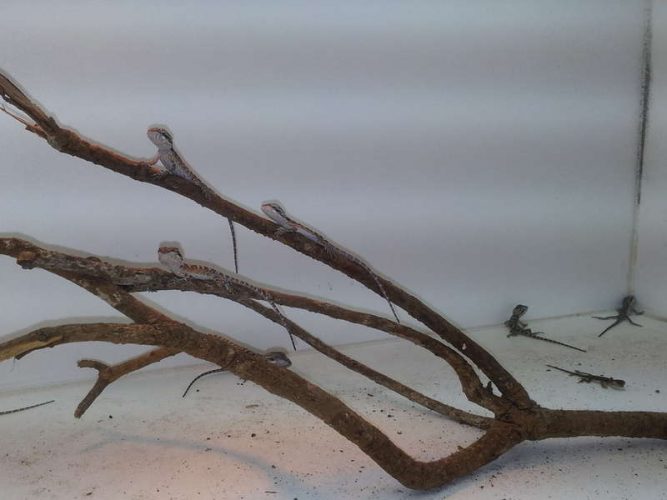
Reproductive problems for male bearded dragons
Knotek (2017) describes the most common reproductive problem for male bearded dragons being:
- hemipenile plugs (seminal plug), and
- prolapsed hemipene.
A hemipenile plug may look to some as an object sticking out of the butt! Plugs sticking out of hemipenis and swollen vent are some of the signs you may see when seminal plugs are present. The tip of the seminal plug that may be visible is hard.
The seminal plugs are a mix of semen and skin cells which can accumulate from unsuccessful attempts to mate with an unreceptive female or premature ejaculation (Raiti, 1995).
The hemipenile plugs (seminal plugs) will cause irritation. It is very possible there is some bleeding inside the hemipenile walls as the soft tissue is irritated by the harder plugs. Like most reproductive issues, these are associated with the quality of care in captivity.
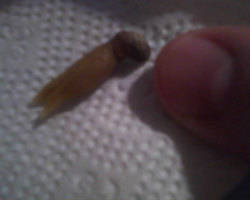
The hemipene are delicate tissue and attempting to remove the hemipenile plugs can result in prolapse or permanent damage. Bathing multiple times over a day may assist in loosening the hard edges of small seminal plugs if they are protruding externally, however it is unlikely to help them come out on their own.
If the hemipene cannot be retracted, call a vet and discuss means to keep the hemipenes moist while waiting treatment.
It is best to involve a vet when plugs are detected. The vet may be able to dislodge the seminal plugs by massaging the hemipenes with antibiotic cream, however surgical intervention may also be required.
If prolapse has occurred then the hemipenes will likely be placed back into the cloaca and stitches in place to prevent it coming back out while recovering (Raiti, 1995). If the hemipene has become necrotic then it will need to be amputated (Raiti, 1995).
Hemipenile plugs are also known as seminal plugs or sperm plugs.
Male bearded dragons that suddenly becomes aggressive are likely associated with season. See the post aggressive bearded dragons.
How can I help my Bearded Dragon Lay Her Eggs
Although trying to massage the eggs out can be very tempting, the potential for rupturing eggs is very high. This may lead to several consequences: egg yolk peritonitis, and internal trauma from jagged shell fragments to name a few.
Avoid excess handling, this condition is incredibly painful. A bearded dragon that is egg bound or has follicular stasis may seem similar but the treatments are different. Seek professional veterinary advice.
As with many conditions in bearded dragons, they have likely been unwell for several days before the outward signs of pain or discomfort are evident. Immediate medical treatment is advised to prevent their condition from spiraling downward.
In the meantime keep your bearded dragon warm and hydrated. A stable patient is a better candidate for surgery, and will tolerate medications better than an emaciated, dehydrated dragon.
If your bearded dragon appears egg bound it is time to call your vet. See the article on bearded dragon egg binding for more support.
7 Steps if a Bearded Dragon Can’t Lay Her Eggs
Here are 7 steps to take if a bearded dragon cannot lay her eggs:
- Call your vet and let them know you need help.
- If your vet cannot see you immediately, it is important to keep handling to a minimum. Provide a nesting box with sand or other substrate suitable for laying and keep her in it until your appointment.
Do not massage the abdomen in an attempt to move the eggs. It is typically ineffective (Knotek et al, 2017) and very dangerous. Ruptured eggs will result in severe inflammation and perhaps death (Melidone, et al., 2008) This is a painful condition, and manipulating the abdomen can cause significant complications. - Provide a warm bath. This can help stimulate contractions and keep your bearded dragon hydrated. If it works, some eggs may be delivered in the water.
- Temporarily add more humidity to the environment and provide a plate or low tray of water that the bearded dragon can walk through as she chooses. Ensure the heating and lighting is appropriate and add a lay box in close proximity of the heat and lighting
- If a prolapse has occurred, it is vital to keep this tissue moist.
- Once at the veterinarian’s office, they will begin with a thorough history including diet, and husbandry. A physical exam may reveal a painful swelling – eggs may or may not be readily palpable.
Blood work may be useful, especially in assessing calcium levels. Low calcium, (either a result of heavy demands of body calcium stores to produce shells, or from inadequate husbandry practices) may result in profound weakness which can inhibit proper muscle contractions.
X-rays may be useful to confirm the integrity of the eggs (i.e. whether or not shells are calcified, and if shells have been broken).
In some cases, if eggs are intact, shells are mineralized, and the veterinarian feels that the patient is healthy enough to attempt to pass the eggs, medical treatment may be attempted. This often includes two medications: a dose of calcium, as well as a hormone called oxytocin. This will induce contractions to hopefully pass the eggs. Of course, this assumes that the oviducts are healthy, that the eggs are within the oviducts (as opposed to free floating in the abdomen), and there is no obstruction present.
This medication has been shown to last about 72 hours. If eggs are passed, a follow-up appointment should be scheduled to repeat the x-ray to confirm all eggs are passed.
Often, these are surgical cases, either necessitated by the failure of medical treatment, or by the inability to determine follicular stasis vs egg bound. During surgery, the impacted eggs are removed.
The reproductive tract may by spared during these surgeries, but the inflammation may inhibit successful breeding in the future. If left “intact” these females may become egg-bound again in the future, especially if measures are not taken to correct predisposing factors. - Many of these cases are complicated by poor husbandry. Take the time to discuss proper diet, light, and housing with your veterinarian.
Other medical conditions may be at play in these patients – a full health assessment should be performed to help rule out other conditions such as metabolic bone disease, kidney issues, and follicular stasis. If considering surgical intervention, speak with your vet about the risks associated with surgery – complications can be severe and are usually out of our control.
Other articles you may be interested in neutering or spaying bearded dragons. For all the baby bearded dragons you hatch, here are the 1000’s of ideas for the best bearded dragon names.
Not sure if your bearded dragon is male or female? See the post on sexing bearded dragons.
Are bearded dragons easy to breed?
Bearded dragons are extremely easy to breed and can deliver multiple fertile clutches from a single mating within a year.
References and Further Reading
- Amey, A. P., and Whittier, J. M. 2000. The annual reproductive cycle and sperm storage in the bearded dragon, Pogona barbata. Australian Journal of Zoology – AUST J ZOOL. 48.
- Amey, A. P., and Whittier, J. M. 2000. Seasonal Patterns of Plasma Steroid Hormones in Males and Females of the Bearded Dragon Lizard, Pogona barbata. General and Comparative Endocrinology 117: 335–342
- Baeckens, S., Edwards, S., Huyghe, K., & Van Damme, R. (2015). Chemical signalling in lizards: an interspecific comparison of femoral pore numbers in Lacertidae. Biological Journal of the Linnean Society, 114(1), 44-57.
- Baeckens, S., Huyghe, K., Palme, R., & Van Damme, R. (2017). Chemical communication in the lacertid lizard Podarcis muralis: the functional significance of testosterone. Behavioral Ecology and Sociobiology, 70(2), 2029-2042.
- Divers, S. J., and Stahl, S. J. (2018) Mader’s Reptile and Amphibian Medicine and Surgery- E-Book. Elsevier Health Sciences.
- Knotek, Z. (DVM, PhD, DECZM (Herpetology)), Cermakova, E. (DVM), and Oliveri, M. (DVM). 2017. Reproductive Medicine in Lizards. Veterinary Clinic Exotic Animals 20: 411-438.
- Lane, E. (2013) Sexual Selection of Beard Color in the Inland Bearded Dragon (Pogona vitticeps) https://core.ac.uk/display/48434275#
- Robertson, P. and Coventry, A. J. (2014) Reptiles of Victoria: A Guide to Identification and Ecology. CSIRO Publishing
- Pianka, Eric, R. (2005) The ecology and natural history of the dwarf bearded dragon Pogona minor in the Great Victoria Desert Australia Draco, 6(N): 63-66 Nr 22.
- Siviter, H. (2015) Does egg incubation temperature impact the long-term behaviour and cognition of bearded dragons (Pogona vitticeps)? Thesis, University of Lincoln.
- Stauber, A. G., and Booth, D. J. (2003) Allometry in the Bearded Dragon Pogona barbata (Sauria: Agamidae): Sex and Geographic Differences. Australian Zoologist. Vol: 32 (2): 238-245
- Thompson S. A., and Thompson G. G. (2003) The western bearded dragon, Pogona minor (Squamata: Agamidae): An early lizard coloniser of rehabilitated areas. Journal of the Royal Society of Western Australia, 86:1-6
- Humane killing of reptiles [Version 1]. Office for Research Ethics & Integrity. Animal Care & Use Standard. University of Melbourne. July 2016 reviewed July 2019


